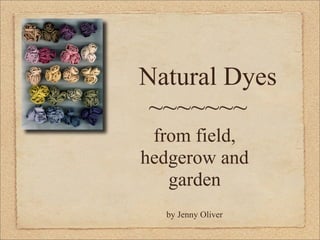
Natural Dyes - a mini presentation
- 1. Natural Dyes ~~~~~~~ from field, hedgerow and garden by Jenny Oliver
- 2. Dyes from trees and shrubs Barks - eg Fruit trees, Oak, Birch Leaves - eg Juniper, Eucalyptus Flowers - eg Hawthorn (May) Fruits - eg Walnut husks, damsons, sloes, Products of parasitism: oak galls
- 3. Dyes from smaller plants Flowers - eg Safflower Leaves & Stems - eg Woad Roots - eg Madder Fungi and Lichens - eg Cudbear and Crottle / Crotal
- 4. Natural dyes from ‘non- vegetable’ sources (and non-UK) Insects - Cochineal, Kermes (unavailable except as museum samples), Lac Molluscs - Tyrian Purple, Dye Whelk Minerals - Copper, Iron, Lead, Mercury & Cadmium
- 5. Wild, or ‘Weeds’ Achillea millefolium - Millefoil, Yarrow Calluna vulgaris - Common Heather Daucus carota - Wild carrot Equisetum spp. - Horsetail Gallium verum - LADY’S BEDSTRAW: related to Madder of Mediaeval fame Hedera helix - Ivy
- 6. Wild, or ‘Weeds’ continued Hypericum perforatum - St John’s Wort Pteridum aquilinum - Bracken Rumex spp - Dock (and others) Symphytum spp - Comfrey Taraxacum officinale - Dandelion Urtica dioica - Nettle Verbascum thapsus - Great Mullein Verbascum at Smarden, normally a single flower spike, but rabbit-nibbling produced this
- 7. Fungi & Lichens ‘Mushroom dyes’ - wide variety Lichen dyes - Parmelia spp. (crottles/crotals), Xanthoria parietina (Yellow wall lichen), Evernia spp (eg ‘oakmoss’ or Stag’shorn Lichen), Ochrolechia tartarea (= ‘Cudbear’) and more. Very ancient methods.
- 8. ‘Salvaged dyes’ Onion skins (yellow & red) Tea (old teabags, or stale leaf tea) Carrot tops Avocado pits and peels Old logs (inner bark) Lichen from fallen twigs
- 9. Processes “Dyer’s stuff” and dyestuffs
- 10. Processes: summary Clean your fibre: ‘Scouring’ Mordant your fibre, if necessary Extract dye from source Dye your fibre ‘Dry in’ then rinse/wash to remove excess dye.
- 11. Processes - scouring Successful scouring of cotton should leave the water looking like this. It has a characteristic odour, too, which cannot (yet) be conveyed by a computer presentation.
- 12. Processes - scouring Badly cleaned Unprepared fibre, Clean fibre fibre grease, gums and dirt
- 13. Processes - mordanting Mordant rule of thumb: Mineral mordant for animal fibres Vegetable mordant for vegetable fibres (often followed by mineral) Eco-friendliest minerals: alum, and some iron salts eg from rusty nails and vinegar Vegetable mordant - tannins: from sumac leaves, oak galls, and even stale tea
- 14. Processes - mordanting But - will not Will accept mordant Clean fibre accept dye compounds, which compounds welcome the dyes
- 15. Processes - Dyeing Methods: Dye ‘in the wool’, in the skein, or piece goods. Boil, simmer, steep over night, steep for days - or weeks.... or just ‘dip’. Leave ‘as is’ or modify.
- 16. Selected Literature & Links Wild Color - Jenny Dean (now out of print) The Art and Craft of Natural Dyeing - J.N. Liles A Dyer’s Garden - Rita Buchanan Plants for a Future - www.pfaf.org The Natural Dyers Yahoo discussion group: groups.yahoo.com/group/ NaturalDyes/ Images courtesy of www.amazon.co.uk
- 17. Dye courses: at the Bushcraft Meet 2-4 May 2009 Concentrating on wild dyestuffs, part of the Bushcraft weekend see http://www.bushcraft-magazine.co.uk/ at the Dering Arms, Kent Dates to be confirmed One-Day Workshop with Lunch The Dering Arms, Pluckley, Kent
- 18. Thank you for viewing!